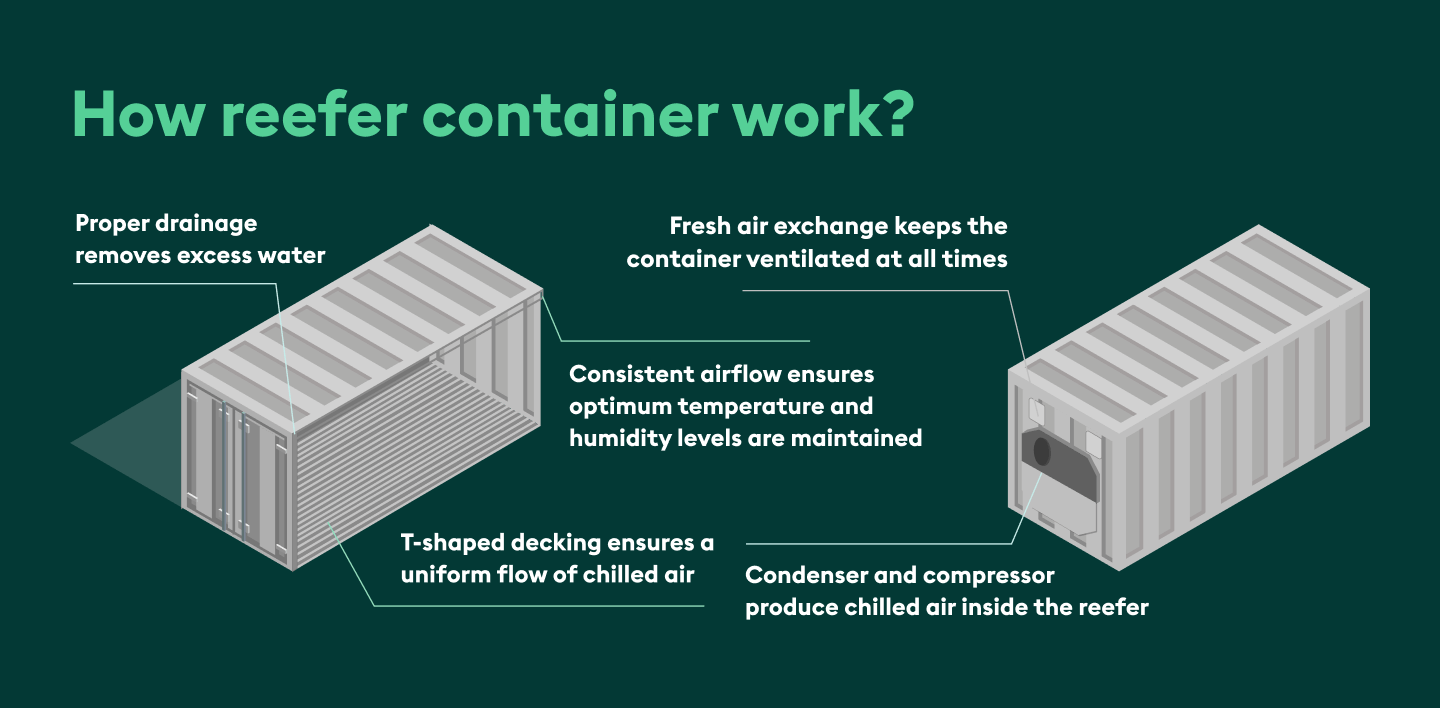Refrigerated containers, also called reefer containers, are used for goods that need to be temperature controlled during shipping. Reefer containers are equipped with a refrigeration unit that is connected to the power supply on board the ship.
What is inside a reefer container?
The following goods are often transported in a reefer container: Fruits and vegetables, meat, fish (fresh or frozen), milk and dairy products, flowers, pharmaceuticals, juice and concentrate and chocolate.
How a reefer container works
These are the features of a refrigerated container:
- They are designed to maintain the temperature, humidity and atmosphere of the container at a constant value during the whole transit time.
- There are 4 settings that must be considered when shipping reefer cargo: temperature, ventilation, humidity and drainage.
- Temperature: All standard reefer containers are built to maintain a temperature between +25° C and -25° C for chilled and frozen cargo. A certain percentage of the global reefer fleet is also capable of maintaining a temperature down to -35° C or even lower. Special containers (super freezers) can maintain a temperature down to -70° C.
- Ventilation: For a chilled temperature, air must flow through the cargo at all times to remove heat and gases. Therefore, the transport boxes used should have ventilation. Fresh air ventilation is required for fruits and vegetables. For frozen goods, air must flow around the cargo. There must be no large gaps between the cargo, the walls and the cargo itself. The cargo should be stowed in blocks.
- Humidity: Some products benefit from a lower level of humidity in the air. A reefer unit has a dehumidification function which can lower the level of moisture in the air. Although some newer units can reach 50%, the standard is between 60% and 85% relative humidity (RH).
- Drains: These are used to release excess water that may accumulate inside the containers. In addition, their design prevents water or insects to get into the container.
- Reefer machinery does not run on its own but needs to be plugged into an electrical source. This source can be at a depot, terminal, on board a vessel or a genset.
Inside the Refrigerated container is a microprocessor, which is the electronic temperature recorder. This device stores all data, such as supply air and return air temperature, remote cargo probe temperatures, defrost activity, changes to the setpoint, power on and off time, etc. In order to record the cargo temperature of certain shipments, cargo probes can be utilised. These probes are cables with a temperature-sensitive element fixed to one end. Kuehne+Nagel offers an additional, carrier-independent monitoring device (portable data logger) that is compatible with our tracking and tracing systems. This provides you insights into the temperature data of your goods at any time.
A refrigeration unit is built to maintain a certain temperature, not to bring the load to the desired temperature. The cargo has to be precooled to the set point temperature prior to loading. Especially for fresh fruits and veggies, reducing the temperature after harvest to the optimal transport temperature is crucial to guarantee good quality and ensure the best possible shelf life.
Reefer container dimensions, sizes and specifications
Please note: although reefer units are manufactured to ISO standards there may be some small differences in dimension and weight.
Reefer 20′
| Inside Length | Inside Width | Inside Height | Door Width | Door Height | Capacity | Tare Weight | Maxi Cargo |
|---|---|---|---|---|---|---|---|
| 17‘8“ | 7‘5“ | 7‘0“ | 7‘5“ | 7‘3“ | 953 Cft | 6,503 Lbs | 60,627 Lbs |
| 5.450 m | 2.285 m | 2.160 m | 2.290 m | 2.225 m | 27 m³ | 2,950 Kgs | 27,500 Kgs |
Reefer 40′ HC (High cube)
| Inside Length | Inside Width | Inside Height | Door Width | Door Height | Capacity | Tare Weight | Maxi Cargo |
|---|---|---|---|---|---|---|---|
| 38‘0“ | 7‘6“ | 7‘1“ | 7‘6“ | 7‘5“ | 2,366 Cft | 10,141 Lbs | 65,036 Lbs |
| 11.590 m | 2.285 m | 2.400 m | 2.290 m | 2.250 m | 67 m³ | 4,600 Kgs | 29,500 Kgs |
What are non-operating reefer containers?
Non-operating reefers (NOR) are refrigerated containers that serve as dry boxes by deactivating the refrigeration unit for the transit time. This enables reefer containers to be redistributed from areas where there is a surplus of this equipment, to areas where there is a shortage. This also helps to fill the otherwise empty space on a ship with cargo. In general, there is a price incentive, considering there is less loading space in a reefer versus a dry container, due to the space taken by the refrigeration machine. Not all ‘dry’ cargoes are suitable to be carried in a reefer. 20ft and 40ft reefer containers


